 |
||
| uvm a - z | directory | search |
 |
DEPARTMENTS LINKS
|

illustration by
KATE DONNELLY
Ripeness Is All
by MARK PENDERGRAST
Long before he was a university president,
Daniel Mark Fogel was a poet and English professor, so he’s on
familiar ground when he looks to Shakespeare for three words to capture
the critical moment facing the University of Vermont. Fogel’s ten-year
vision for the University, an ambitious, detailed document, closes with
the bard’s assertion that an abundant harvest is in the timing
— “Ripeness is all.”
The metaphor also implies possible disaster if the fruit is left
to hang;
UVM could slowly decay into mediocrity, failing to fulfill Fogel’s
vision. Or, plucking this perfect moment, building upon recent
upswings in undergraduate applications, record research funding,
and a new era of leadership and confidence on campus, the University
could grow, investing in students, faculty, facilities, and programs
to achieve a solid fiscal foundation and attain a status unique among
American institutions of higher learning. In the president’s words:
“…an internationally distinguished research university
that offers undergraduates the human scale, flexibility, and responsiveness
of a liberal arts college.”
If that future is a piece of fruit just waiting to be picked, then money,
to a large extent, is the ladder that will allow the University to reach
the high branches. On Homecoming Weekend in early October, President
Fogel and the UVM Board of Trustees officially launched The Campaign
for the University of Vermont. Such a venture is often called a capital
campaign, but Ian deGroot ’79, vice president of UVM Development
and Alumni Relations, stresses that this is, more accurately, a comprehensive
campaign. It’s an important distinction, because the $250 million
the Uniersity aims to raise will primarily fund scholarships for students
and support for faculty positions rather than bricks and mortar, though
some new buildings are also part of Fogel’s plan. “This is
a campaign about people, by and large,” deGroot emphasizes.
Although the official fundraising is just getting under way, deGroot
and his team have been working overtime to give it a jump-start. Typical
of higher education campaigns, a “quiet phase” has preceded
the public kick-off. Despite the recent economic slump, the University
has secured pledges for roughly $115 million from major donors, more
than the entire first UVM campaign raised a decade ago.
Money is a commodity much on the minds of university administrators
across the country, but UVM’s self-confident, enthusiastic campaign
launch is a rarity in the current doleful atmosphere in which many institutions
of advanced learning are struggling just to keep their heads above water.
“Higher education funding is a mess,” says Will Doyle, a senior
policy analyst at the National Center for Public Policy and Higher Education.
“The budget situation in the states is among the worst we’ve
seen since World War II.”
During the late 1990s boom, with capital gains and stock market advances
acting as golden geese, many legislatures committed to the improvement
of primary and secondary education, while spending more on higher education
as well. Then the economic bubble burst, which came as a shock to many
states, faced with overcommitments, lowered revenue, and inability to
raise taxes. “So in most states, we are seeing cuts to higher education,”
Doyle says.
Thus in Massachusetts, state support is way down and tuition up. From
fiscal year 2002 to 2003, Doyle says, Bay State tuition rose 25 percent
at public four-year colleges, and another 15 to 20 percent hike is likely
from fy2003 to fy2004. Other states are in similar binds. Claire Van
Ummersen, vice president of the American Council on Education, adds
that “almost all states have constitutional edicts that they must
balance their budgets. They have certain mandates, such as prisons,
care of the elderly, and k-12 schooling. That means that the higher
education allotment must come from discretionary budget dollars. In
this atmosphere, diversifying sources of revenue is very important for
all public institutions. It sounds to me as if UVM is making a leap
in that direction with its comprehensive campaign.”
The University of Vermont is in a better position than most public institutions,
a result of history and circumstances that many UVM administrators and
supporters have, ironically, bemoaned in the past. As a part-private,
part-public institution, UVM receives less than 10 percent of its funding
from the state of Vermont, so it is much less dependent on the tax-paying
public, leaving it with an enviable flexibility. While it hasn’t
received as much tax-based support as other public universities, it
also isn’t overly dependent on the state. On the downside, the
University has historically been dependent on high tuition rates, particularly
for non-Vermont students, to keep the enterprise afloat. It’s a
budget scenario that many other state universities now face themselves.
HARDSCRABBLE U
Dig as much as you like into UVM history, you’ll be hard- pressed
to unearth a golden era of financial well-being. Despite its name, the
University of Vermont was founded primarily as a private school that
was supposed to be self-supporting. The fifth New England higher-education
institution — chartered in 1791 after Harvard, Yale, Dartmouth,
and Brown — UVM could never rely on tax support from its small,
rural population of farmers. Real estate speculator Ira Allen grandly
promised seed money of 4,000 pounds to found the University, but despite
his good intentions, he never produced all of the money, instead fleeing
his creditors in disgrace in 1803.
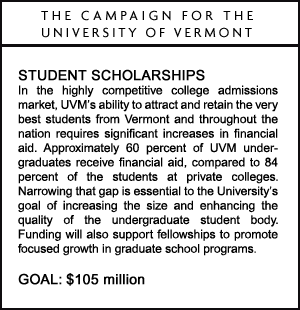 Looking
back, it is miraculous that the institution survived, says Bob Stanfield,
a retired UVM sociology professor who served as former UVM President
Lattie Coor’s executive assistant for 15 years. A wealth of UVM
history committed to memory, Stanfield rattles off some of the grim
statistics, from the University’s near collapse after the War of
1812 to the fact that the graduating class of 1866 had a mere three
students.
Looking
back, it is miraculous that the institution survived, says Bob Stanfield,
a retired UVM sociology professor who served as former UVM President
Lattie Coor’s executive assistant for 15 years. A wealth of UVM
history committed to memory, Stanfield rattles off some of the grim
statistics, from the University’s near collapse after the War of
1812 to the fact that the graduating class of 1866 had a mere three
students.
By that time the University was newly incorporated as The University
of Vermont and State Agricultural College, the result of Vermont Congressman
Justin Morrill’s successful lobbying to pass the federal Morrill
Act in 1862, which funded state land grant schools for agriculture and
mechanical arts. For the first time, this new Vermont educational corporation
was at least partially funded by officially allocated public funds.
Fast forward a half-century to the paternalistic presidency of Guy Bailey,
who served from 1919 until his death in 1940, when the University first
attracted major private donations. James Wilbur of Manchester, Vermont,
a wealthy businessman and would-be scholar, favored the idea of Ira
Allen as a visionary, not just an absconding scalawag. In addition to
writing a laudatory biography of his hero, Wilbur funded a statue of
Allen on the University Green and the chapel in his name. In his 1929
will, Wilbur also left $3 million to endow UVM scholarships. That initial
gift has had a profound effect on generations of undergraduates, and
the Wilbur Fund endowment has now grown to approximately $15 million,
providing financial aid to more than 300 students annually. Wilbur provided
an early example of the kind of lasting impact a major gift can have.
Even with James Wilbur’s generosity, there wasn’t enough money
in the operating budget during the Depression. In order to pay off a
million-dollar deficit that came to light upon Guy Bailey’s death,
a special session of the legislature appropriated $500,000 on the condition
that UVM raise the other half. For the first time, the University called
on its alumni for help, and despite the onset of World War II, they
rose to the challenge. Thus began an annual giving campaign.
So things stood in 1952, when Carl Borgmann took over as UVM president.
Accustomed to well-funded midwestern public universities, Borgmann was
appalled to learn that the Vermont legislature made no regular appropriation
to the University, just specific grants to the medical school and agricultural
college. Borgmann campaigned vigorously for a state law giving a tuition
break to Vermont students that would be supported by an annual state
appropriation. Passed in 1955, the complex bill added three governor-appointed
trustees to the board, specified lower tuition for in-state students
to be subsidized by taxpayers, and called UVM an “instrumentality
of the state.”
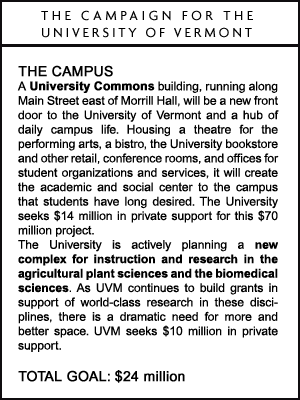 Bob
Stanfield shudders as he recounts the story. “Carl Borgmann skated
on the edge of what might have been the biggest mistake in the history
of the University of Vermont,” he says. “Thank God the lawyer
who drafted the bill said instrumentality of the state instead of agency.”
Still, the legacy of the 1955 bill has been problematic enough in Stanfield’s
estimate. He points out that there has been no year in which the sum
of the state appropriation and resident tuition has covered the full
cost of educating every Vermonter enrolled.
Bob
Stanfield shudders as he recounts the story. “Carl Borgmann skated
on the edge of what might have been the biggest mistake in the history
of the University of Vermont,” he says. “Thank God the lawyer
who drafted the bill said instrumentality of the state instead of agency.”
Still, the legacy of the 1955 bill has been problematic enough in Stanfield’s
estimate. He points out that there has been no year in which the sum
of the state appropriation and resident tuition has covered the full
cost of educating every Vermonter enrolled.
In retrospect, many look back on the Lattie Coor years (1976-1989) as
some of the University’s strongest. Coor was a charismatic personality
and an impressive speaker who articulated a vision to restructure the
undergraduate curriculum, enrich out-of-classroom life, and improve
the relationship with the state of Vermont. It was during these years
that UVM revelled in its “Public Ivy” status, a designation
bestowed by Richard Moll’s book spotlighting schools that delivered
Ivy League educational experiences at much lower public university tuitions.
In 1987, near the end of his UVM tenure, Coor initiated Vermont’s
first major fundraising campaign. It wouldn’t be easy. The effort
weathered Coor’s departure to become president of Arizona State
University, followed by a series of major leadership transitions. In
all, five presidents or interim presidents held the office in Waterman
before the campaign concluded in 1993. Yet the $100 million goal was
met and annual support increased dramatically during the campaign years.
HUNGRY FOR LEADERSHIP
Plagued with ongoing budgetary crises, faculty discontent, and frequent
rumbles of campus unrest for the balance of the decade, UVM appeared
to face a troubled future as it headed warily into the 21st century
and the economy turned bearish. In a way, however, that time may be
a boon for Dan Fogel and the new comprehensive campaign.
“We went through a very difficult period during which there was
no one who put forth and executed a compelling vision for the institution,”
Ian deGroot says. “We were all extremely hungry, eager for strong
leadership. Everyone realized that this next president needed to be
extremely successful. That’s when Dan Fogel came to this campus.”
Fogel recalls being impressed as he learned more about UVM’s past
and potential during the interview process. “The trustees were
already planning the $250 million campaign, and they gave me a 20-page
document, a detailed outline of the character, nature, organizational
culture, and challenges facing UVM,” Fogel says. “At the first
of my many UVM interviews, I was sitting on the edge of my seat, with
a very clear sense that the University would succeed or fail on the
strength of the next president. It was make or break. That appealed
to me.”
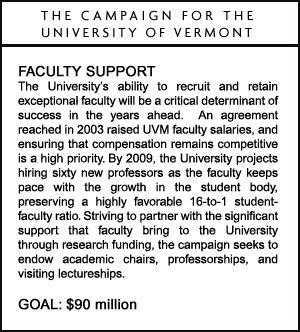 Grant
Gund, who graduated from UVM in 1991 and now runs Megunticook Management,
a Boston venture capital firm, observes that “the campus felt unfocused
in the pre-Fogel era.” As a member of the Board of Advisors for
the College of Arts and Sciences and a member of the Reunion Gift Committee,
Gund has been back to campus several times in the last year. “I
have felt a much greater sense of pride in the school from everyone
— faculty, students, and alumni,” he says.
Grant
Gund, who graduated from UVM in 1991 and now runs Megunticook Management,
a Boston venture capital firm, observes that “the campus felt unfocused
in the pre-Fogel era.” As a member of the Board of Advisors for
the College of Arts and Sciences and a member of the Reunion Gift Committee,
Gund has been back to campus several times in the last year. “I
have felt a much greater sense of pride in the school from everyone
— faculty, students, and alumni,” he says.
Bruce Lisman ’69, a member and former chair of the Board of Trustees,
chair of the National Campaign Steering Committee, and managing director
for Bear Stearns in New York City, is also impressed. When Fogel was
appointed, Lisman called him “the right person at the right time
for our University” and he has not been disappointed. “I am
a huge Fogel fan,” Lisman says. “He’s the most exciting
thing that has happened on this campus in years. He believes in active
leadership, managing the place, working within the greater Burlington
community and throughout the state. He has shown tremendous energy talking
about his vision and the steps needed to get there.”
Fogel reminds Bob Stanfield of Lattie Coor in many ways, but Coor often
spoke in sentence fragments. Even the most impromptu Fogel remarks,
in contrast, are fully-crafted thoughts. In photographs, he often looks
directly at the camera with the same deep-set eyes and quizzical smile
with which he addresses faculty, students, staff, legislators, mayors,
and journalists.
In an interview at his home, Fogel lays out his case for the $250 million
comprehensive campaign, beginning with a familiar reality check. While
acknowledging the validity of the point made by Stanfield and others
regarding the interplay of state funding and tuition, the president
embraces UVM’s public character and obligations, and his belief
is firm that Vermont is doing all that it can for the University. “UVM
is almost unique in that of all state flagship universities, it gets
the lowest funding, in both absolute dollar terms and percentage of
overall expenditures. All of my predecessors have complained about this,
but I don’t,” he says. “We get $37 million a year from
the state. Obviously, we could not do without the state appropriation,
and we’re grateful for it. We must face the reality that Vermont
is a very small state, with only a little more than 600,000 people.
It is already a tremendous stretch to support its prisons, handle environmental
regulation, transportation, early childhood and k-12 education, social
welfare. To support a university in addition to all of that is extraordinary.
Most cities of 600,000 wouldn’t dream of supporting such a university
of our quality and complexity.”
With this acceptance of the inevitable limitations on public funding
comes a commitment to driving harder to boost private support. That
quest is a major part of the work of any higher education president,
public school or private, in these times. As usual, Fogel is both emphatic
and precise in his explanation of how he’ll use increased financial
support to build a better university.
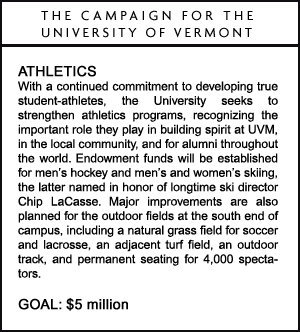 For
one thing, he wants to grow the student body, a move that will foster
financial sustainability. He points to the enormous surge in student
numbers and quality this fall to bear out his conviction that the projected
increases are both realistic and overdue.
For
one thing, he wants to grow the student body, a move that will foster
financial sustainability. He points to the enormous surge in student
numbers and quality this fall to bear out his conviction that the projected
increases are both realistic and overdue.
“Of all the land-grant universities that have medical schools,
we are the smallest by far,” Fogel says. From its current size
of nearly 11,000 students, the president wants to grow to approximately
13,000. He will add faculty to maintain a 16-to-1 student-teacher ratio,
but there will be no need to add deans, classrooms, or new libraries.
“We need to take advantage of the potential economies of scale.”
In order to do this, UVM needs to ride an upward trajectory in both
quantity and quality of applicants, a trend that accelerated during
Interim President Edwin Colodny’s tenure and that continues to
pick up steam in the Fogel era.
In the highly competitive world of undergraduate admissions, UVM needs
to step up its game in order to build enrollments. Key to that, says
Fogel, is improving the quality of campus life in a number of ways.
The University has contracted with architects to design a new multi-use
student union, the University Commons, a center where the academic and
the social life of campus will come together. New residence halls and
extensive hall renovations are in the works. A sharpened focus in athletics
may put more games in the win column and fans in the bleachers, boosting
school spirit. Academically, a new Honors College promises to enrich
the undergraduate experience University-wide.
While other states are hiking tuition rates in huge, startling increments
to deal with state funding cuts, Fogel plans to raise UVM tuition moderately,
only a few percentage points annually. Still, UVM tuition is already
a stretch for many, and in order to attract the bright students it is
after, Fogel emphasizes, the University must offer substantial scholarships,
based both on need and merit.
In order to do all this, the University needs to land major donations
that can be put to use immediately and also invest long-term to drive
significant growth in the all-important endowment.
“Most of our private peers derive 30 to 40 percent of their annual
expenditures from endowment earnings. We derive less than 6 percent,”
Fogel says. He wants to change that by raising a $1.2 billion endowment
within the next 15 years. “A lot of people think that’s an
impossible dream,” Fogel says. “But it’s quite doable.”
When he was the provost at Louisiana State University (where the chief
financial officer was among those reporting to him) Fogel discovered
that, although he is an English professor, he likes crunching numbers.
He’s eager to do the math for you.
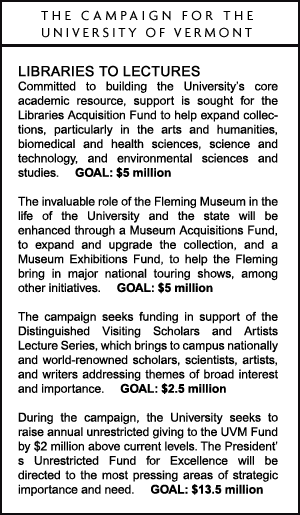 “Our
current endowment is around $200 million. If we complete this campaign
successfully by 2007, then we can bring the endowment to around $400
million,” Fogel says. “Then, even if we did nothing more for
the next ten years, that money should double through investments. So
by the year 2017, we would have $800 million, even if we didn’t
raise another penny. By 2009-2010, we should be launching our third
comprehensive campaign, for something like $500 million over six or
seven years. So by the time we get out to 2017, the endowment should
be well over a billion dollars.”
“Our
current endowment is around $200 million. If we complete this campaign
successfully by 2007, then we can bring the endowment to around $400
million,” Fogel says. “Then, even if we did nothing more for
the next ten years, that money should double through investments. So
by the year 2017, we would have $800 million, even if we didn’t
raise another penny. By 2009-2010, we should be launching our third
comprehensive campaign, for something like $500 million over six or
seven years. So by the time we get out to 2017, the endowment should
be well over a billion dollars.”
With a number of major donors leading by example, Ian deGroot and his
development team are looking to make those numbers real. Mike Schultz,
assistant vice president for Development and Alumni Relations, notes
that longer term commitments and pledges are up. “I think it’s
a plus that we haven’t had a campaign in ten years. People had
been sitting on the fence. There’s some real pent-up desire, and
now Dan is here with a sustainable vision for the University, leading
the charge. Giving money to UVM right now is a vote of confidence that
a lot of people are making.”
By the time UVM has built a billion-dollar endowment, Fogel, now 55,
may have retired, but he is emphatic about staying the course. “I
want to be here for ten years or more. This institution needs stability.”
He pauses. “Rachel and I grew up in Ithaca. We wanted to come home
to the Northeast, we wanted to run a flagship university that is indispensible
to its state. Everything here feels right. Arriving at the University
of Vermont at this particular moment feels like coming home.” Ripeness
is all.
Mark Pendergrast is an independent scholar and author living in Colchester,
Vermont. His latest book is Mirror Mirror: A History of the Human
Love Affair with Reflection (Basic Books, 2003).
